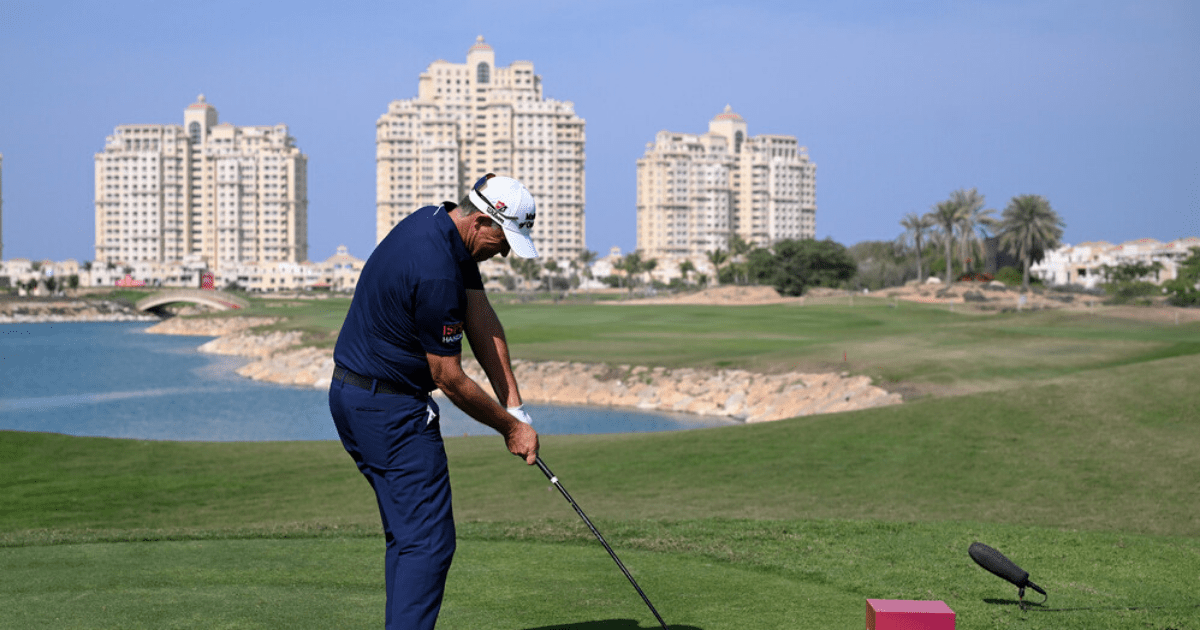Hold your finish
According to three-time major winner and Ryder Cup captain Padraig Harrington, one simple change can have a big impact on your golf swing. Harrington advises players to hold their finish after hitting the ball, as it promotes balance and stability. He even suggests emulating Tommy Fleetwood's finish to maximize your swing's effectiveness.
Waggle
If you want to look like a pro on the golf course, Harrington has a tip for you – incorporate a waggle into your pre-shot routine. By moving the club around and giving it a little waggle, you'll exude confidence and appear more like an experienced player.
Don't be stiff
Contrary to popular belief, Harrington advises against keeping your head down and standing still during your swing. He urges golfers to let their head be free and embrace movement. According to Harrington, planting your feet is "complete rubbish." So loosen up and let your body flow.
Lash it
If you're new to the game of golf, Harrington suggests an unconventional approach. Instead of focusing on accuracy right from the start, he advises beginners to prioritize power and speed. By swinging as hard as you can and really lashing the ball, you'll build strength and distance. Accuracy can come later.

Mentality
Harrington emphasizes the importance of mental strength in golf. While physical talent is crucial, it's the mental side of the game that sets the pros apart. According to Harrington, everyone has a unique combination of physical and mental abilities, and it's the quest for perfection and mental resilience that ultimately leads to success.
Love it
Above all, Harrington stresses the importance of loving the game of golf. Despite the challenges, setbacks, and tough competition, having a deep passion for the sport is what will keep you going. Harrington's own love for golf has fueled his successful career, and he encourages aspiring players to embrace the same mindset.
Padraig Harrington shared these tips during an exclusive interview with SE at Al Hamra Golf Club in Ras Al Khaimah, UAE. As a three-time major winner and Ryder Cup captain, Harrington's insights are invaluable for golf enthusiasts of all levels.
Frequently Asked Questions
Can pro golfers train too much?
Professional golfers are at risk of overtraining. Excessive practice can cause physical injuries, such as tendinitis, or mental burnout. Listening to your body, prioritizing recovery time and maintaining a balanced schedule are essential for golfers. Quantity is not as important as quality, and the emphasis is on deliberate, focused practice. Rest days, strategically planned into their schedules, allow the mind and body to be sharpened.
Are pro golfers more focused on mental or physical training?
Professional golfers recognize the necessity of both physical prowess and mental fortitude within their sport. Their training emphasizes the balance between both. Although a lot of time is spent on physical training and fitness in order to increase strength, flexibility, endurance and flexibility, mental training does not go unnoticed. Mental training for pro golfers includes visualizing shots, managing stress and anxiety on the course and strategic thinking. A golfer might work with sports psychologists to develop mental resilience and focus, which are indispensable during competitive rounds.
How do professional golfers use rest and recovery to their advantage?
The training regimen of a pro-golfer is based on recovery and rest. Adequate rest improves performance because it allows the body’s healing and rejuvenation, which prevents injury and fatigue. Golfers adopt a variety of recovery tactics such as sleep optimization, active recovery, massage therapy, and stretching. During their rest periods, golfers may engage in activities that encourage recovery without overworking the body. Such practices are vital in sustaining high performance throughout the strenuous tour schedules.
What are some common injuries pro golfers face, and how do they prevent them?
Back pain, wrist injuries and tendinitis are common injuries for professional golfers. Prevention strategies are a key component of their training programs, entailing regular fitness exercises focused on strengthening the muscles used in golf and increasing flexibility. Golfers can also use swing analysis in order to ensure they are not overstressing their bodies. Warm-up exercises, good nutrition, and consultations with physical therapists can all help prevent injury.
Statistics
- Studies show that consuming a balanced diet is a priority for 95% of professional golfers as part of their training protocol.
- According to a fitness survey, 55% of professional golfers prioritize yoga and pilates for improving flexibility and core strength.
- Technology such as launch monitors are used by 85% of professional golfers in their training routines.
- Professional golfers under the age of 25 spend, on average, 10% more time on driving range practice compared to those over 25.
- Nearly 80% of professional golfers engage in regular physical fitness programs designed specifically for golf.
- On average, professional golfers dedicate 30 to 40 hours per week practicing various aspects of their game.
- Approximately 65% of a pro golfer’s training time is allocated to short game practice, including putting and chipping.
- About 70% of professional golfers report practicing in adverse weather conditions to improve their adaptability to the elements.
External Links
golfchannel.com
golfdigest.com
tpi.com
golfsimulatorguys.com
18strong.com
golfscience.org
- Golf Science
titleist.com
pga.com
How To
How to Implement Effective Putting Drills in Golf Practice
Effective putting drills are designed to improve consistency and confidence around the greens. Pro golfers should establish a routine that includes putting from various distances, targeting both straight and breaking putts. Drills that encourage a consistent stroke can improve accuracy. Using putting aids and gates can provide visual feedback and help refine alignment and stroke path. Regularly replicating tournament conditions can be achieved by regularly practicing scenarios that put you under pressure.

